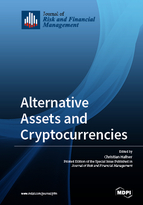Alternative Assets and Cryptocurrencies
A special issue of Journal of Risk and Financial Management (ISSN 1911-8074). This special issue belongs to the section "Financial Technology and Innovation".
Deadline for manuscript submissions: closed (28 February 2019) | Viewed by 142372
Special Issue Editor
Interests: financial econometrics
Special Issues, Collections and Topics in MDPI journals
Special Issue Information
Dear Colleagues,
In times of low interest rates, classical fixed-income type investments become less attractive, while the risks of speculative bubbles in stocks and real estate increase. Crises such as the global financial crisis 2007–09 or the European debt crisis 2011–12 amplify the need for diversification and safe haven investments, a role traditionally played by gold. Recently, there has been an increasing academic interest in alternative investments such as fine art, wine, diamonds, classical cars, watches, and many other physical goods. Typically, heterogeneity of the investments hampers construction of price indices and performance analyses. Cryptocurrencies share some features of alternative assets such as low correlation with financial markets, but they are non-physical, without an intrinsic consumption value, and still suffer from extreme volatilities, which explains why hedge funds remain reluctant to include them in their portfolios. However, this may change in the future with higher market maturity and less volatility. This Special Issue will collect papers addressing alternative assets and cryptocurrencies from financial, economic or econometric viewpoints. Topics include properties of cryptocurrencies, construction of price indices, portfolio diversification, performance evaluation, prediction, volatility and correlation modelling, correlation with financial markets, extreme value analysis, statistical and time series properties, risk management, etc.
Prof. Dr. Christian Hafner
Guest Editor
Manuscript Submission Information
Manuscripts should be submitted online at www.mdpi.com by registering and logging in to this website. Once you are registered, click here to go to the submission form. Manuscripts can be submitted until the deadline. All submissions that pass pre-check are peer-reviewed. Accepted papers will be published continuously in the journal (as soon as accepted) and will be listed together on the special issue website. Research articles, review articles as well as short communications are invited. For planned papers, a title and short abstract (about 100 words) can be sent to the Editorial Office for announcement on this website.
Submitted manuscripts should not have been published previously, nor be under consideration for publication elsewhere (except conference proceedings papers). All manuscripts are thoroughly refereed through a single-blind peer-review process. A guide for authors and other relevant information for submission of manuscripts is available on the Instructions for Authors page. Journal of Risk and Financial Management is an international peer-reviewed open access monthly journal published by MDPI.
Please visit the Instructions for Authors page before submitting a manuscript. The Article Processing Charge (APC) for publication in this open access journal is 1400 CHF (Swiss Francs). Submitted papers should be well formatted and use good English. Authors may use MDPI's English editing service prior to publication or during author revisions.
Keywords
- properties of cryptocurrencies
- construction of price indices
- portfolio diversification
- performance evaluation
- prediction
- volatility and correlation modelling
- correlation with financial markets
- extreme value analysis
- statistical and time series properties
- risk management





